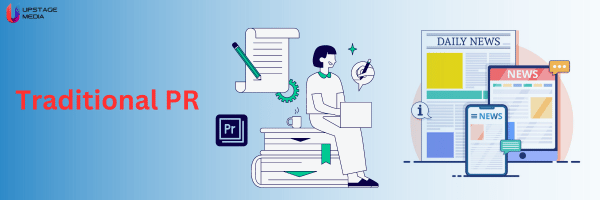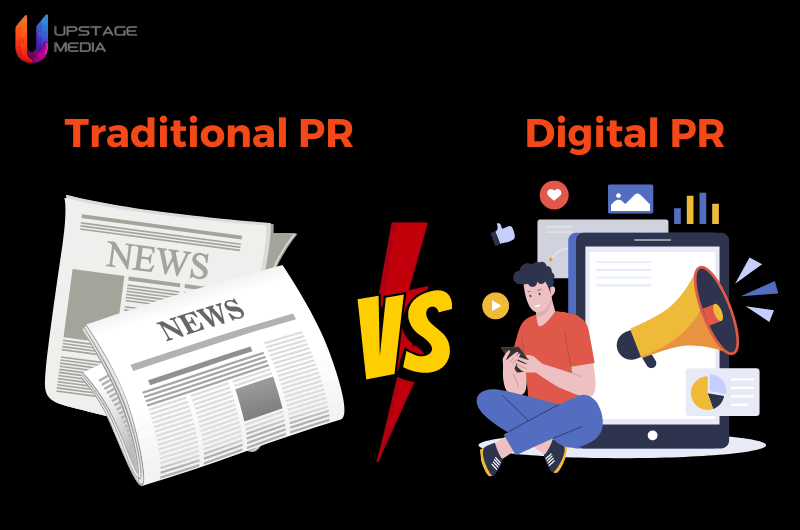Table of Contents
Recently updated on July 16th, 2024
Any business must priorities brand awareness to ensure recognition. Public relations (PR) has undergone rapid change as the communication landscape, giving rise to dynamic digital PR. Traditional PR techniques are given new life by the incorporation of digital technology, which calls for a closer evaluation of the distinctions between these two method’s
What is Traditional PR?
Using traditional media including newspapers, magazines, TV, and radio, traditional PR is a reputation management strategy for people, businesses, or organisations. Reputation-related problems may be anticipated and resolved with the help of crisis managements.
Traditional PR: Exploring the Basics
Traditional PR focuses on managing reputation through well-known platforms including newspapers, periodicals, TV, and radio. It makes use of strategies including press releases, media interactions, and personal involvement to sway public opinion and promote a favourable brand image. Traditional PR struggles to adapt to the rapidly evolving digital communication environment, despite its previous success.

Traditional PR struggles with the necessity to include digital methods for all-encompassing outreach as the digital world changes. Online platforms, social media, and content optimisation must be used in order to achieve this. A brand’s reputation is greatly influenced by its online presence, in-person interactions, and engagement with digitally sophisticated people. By adapting to this dynamic transformation, conventional PR will continue to be effective in a world that is primarily digital.
What is Digital PR?
Digital PR is an essential part of advertising that utilizes web channels to increase audience commitment, and increasing popularity. This includes virtual entertainment, sites, websites, webcasts, online magazines, and web search tools, it uses different strategies to draw in with online crowds effectively.

Digital PR agencies incorporate virtual entertainment, the executives, force to be reckoned with cooperation, the advancement of engaging web content, site design improvement (Web optimization), and cautious perception of online discourse. The fundamental objectives are to make a positive web notoriety, really convey designated messages, and do it in a proactive way.
The speed, impressive range, and intuitive nature of the web are undeniably utilized by computerized PR to give continuous communication and accurate crowd focusing on.
Digital PR: Navigating the Online Realm
Digital PR successfully navigates the online space by utilizing tactics including social media management, working with influencers, creating interesting content, and search engine optimization (SEO). Utilizing the quickness and wide reach of the internet, it makes use of platforms like websites, blogs, social networks, and online newspapers to curate brand reputation.
Success in digital PR depends on an understanding of online dynamics, keeping up with rapidly changing digital trends, and skillfully interacting with target audiences to increase brand awareness and foster meaningful relationships.
Key Differences Between Traditional and Digital Public Relations
1. Communication Paths
Traditional PR relies on credible media channels to disseminate its messages, including newspapers, magazines, radio, and television. In contrast, digital public relations uses online media to engage audiences, including social media, websites, blogs, podcasts, and online magazines. This modification enhances precise demographic targeting and broadens the message’s visibility on digital platform’s
2. Audience Reach and Targeting
Using traditional media including magazines, newspapers, radio, and television, traditional PR mostly targets local or niche audiences. Digital public relations, on the other hand, may reach a worldwide audience thanks to internet platforms, social media, blogs, and websites.
3. Speed and Timeliness
Digital PR enables rapid information delivery and prompt response to trends or breaking news. Traditional PR, in comparison, has greater lead periods because of editing deadlines, printing schedules, and distribution procedures, which might affect timely communication.
4. Measurability and Analytics
In order to make data-driven decisions, digital PR agencies can analyze website traffic, engagement, conversions, and audience demographics thanks to the vast measurement and analytics tools provided by digital public relations. Circulation figures, media mentions, and surveys are frequently the only methods used in traditional PR measurement.
5. Content Format and Creativity
Greater inventiveness and material type flexibility are available with digital PR. Digital public relations (PR) provides for a variety of material forms such as films, infographics, interactive quizzes, and live streaming, whereas conventional PR frequently depends on press releases and standardised media formats. With this creative flexibility, companies can communicate their stories in unique and engaging ways that draw in online audience’s
6. Interactivity and Engagement
Greater interaction and engagement opportunities are provided by digital public relations. Brands may engage in-person dialogues, receive feedback, and develop connections through social media, direct messages, and comments. Traditional PR offers less face-to-face communication but earns credibility from reputable media sources.
Benefits of Traditional PR
1. Credibility from Reputable Sources: Traditional PR that is highlighted in reputable media supports a brand’s credibility.
2. Community Connection: Conventional PR places an emphasis on reaching out to local audiences by using local media like radio, TV, and newspapers.
3. Real, enduring brand presence: Print and magazine media provide the company a real, enduring presence.
4. Wide Age Appeal: Traditional PR, regardless of its online presence, appeals to a wide age range, having a major demographic influence.
Benefits of Digital PR
Following are some advantages of digital PR:
- More quickly and efficiently disseminate information
- Establish enduring connections with the target market
- Develop your online authority
- Increase brand awareness
- Promote the reputation of the company.
Challenges of Traditional PR in the Digital Age
1. Restrictions on Audience Reach: Traditional PR struggles to match the wide audience reach attained through digital platforms.
2. Delayed Engagement: Quick responses to new trends and audience interactions are hampered by the lack of rapid participation.
3. Inadequate Metrics: In the modern digital environment, conventional PR lacks the exact digital statistics necessary for efficient campaign evaluation.
Challenges of Digital PR
1. Drowning in Online Data: Navigating the huge digital environment sometimes leads to information overload, which makes it difficult to get visibility.
2. Constant Flexibility: Digital public relations plans must be constantly modified to account for the quickly changing internet trends and algorithms.
3. Rapidly Spreading Negativity: The necessity for efficient reputation management strategies is highlighted by the speed with which negative evaluations may spread online.
Integrating Traditional and Digital PR
Use influencers as journalists
In traditional PR, relationships with journalists are routinely cultivated in an effort to increase favourable brand exposure. Similar to this, social media influencers with sizable fan bases keep solid relationships with their followers.They provide digital marketing teams with a useful technique to engage with people and improve brand perception since they are reliable and genuine.
Distributing news releases using own digital platforms
Traditional PR is founded on the basis of press releases. These press releases, which are typically given to journalists as the main point of a news article, effectively communicate significant brand news.
But you may reach your target audience directly by disseminating press releases using owned digital marketing channels like your own blog, social media, and email.
Conclusion
Though they may follow distinct paradigms, traditional PR and digital marketing have the same objectives: brand publicity, perception, and value. For a coordinated plan that aids you and your clients in achieving your company goals, use the advice above and combine it with the other tactic.
Frequently Asked Questions
Yes, traditional public relations is relevant in some settings, such as local community participation, building reputation, and addressing older audiences through established media outlets.
Digital public relations is greatly aided by social media since it allows for instant communication, specific audience targeting, viral potential, and the growth of brand communities.
Traditional PR frequently helps sectors like banking, healthcare, and government gain credibility and reach a wide audience.
Metrics include traffic to websites, participation on social media, conversion rates, mentions in the media, sentiment analysis, and an increase in online exposure.
Prominent firms frequently mix strategies, favoring digital public relations for real-time interaction and audience access online while integrating conventional PR for credibility and wider reach.
The combination of these tactics unites the well-established credibility of conventional PR with the dynamic advantages provided by digital public relations, thereby magnifying the brand’s overall effect.
